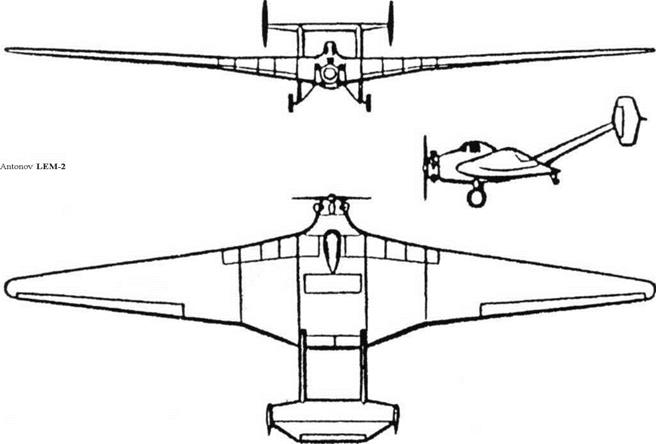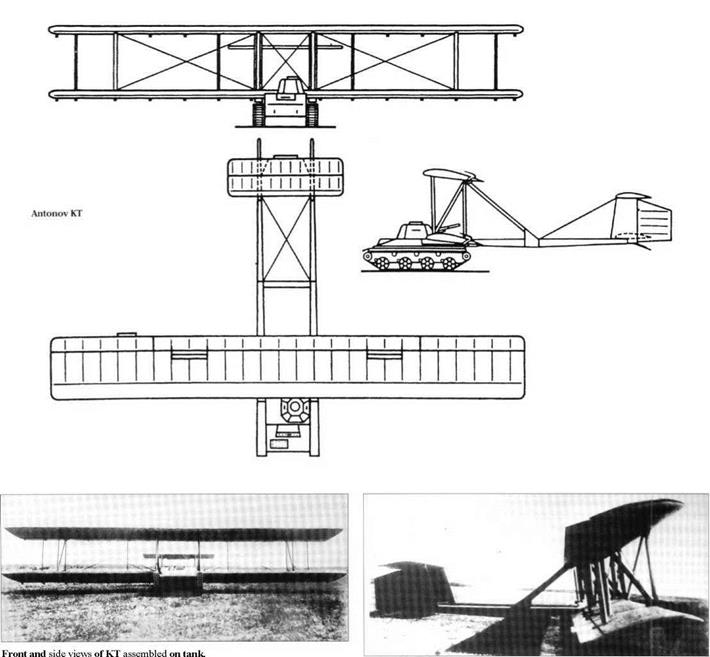Antonov LEM-2
Purpose: To investigate the maximum load that could be carried by an aeroplane powered by a single M-l 1 engine.
Rivals included the Grokhovskii G-31 and KhAI-3, both described later.
Design Bureau: Oleg K Antonov, Kiev.
The idea was that of L E Malinovskii, Director of the Civil Aviation Scientific-Technical Institute (hence the designation). AviAvnito and Osoaviakhim (the Society of Friends of Aviation and the Chemical Industry) provided funds in 1936, enabling the Kiev (Ukraine) constructor to create his first powered aircraft. The single example built was given the OKB designation of OKA-33, because it was their 33rd design. The flight-test programme was opened by test pilot N I Ferosyev on 20th April 1937. Results were satisfactory.
The LEM-2 was predictably almost a flying wing, based on the aerodynamics of Prof V N Belyayev, with a PZ-2 aerofoil modified from the common CAHI (TsAGI) R-ll. The M-l 1 five-cylinder radial, rated at l00hp, was mounted on the front in a long-chord cowl
ing, driving a two-blade carved-wood propeller of the type mass-produced for the U-2 (later called Po-2). Construction was almost entirely wood, with ply skins of varying thickness. The wing comprised a centre section and two outer panels with long-span but narrow ailerons. The inboard part of the wing had a chord of 6.7m (22ft) and so was deep enough (1.47m, 4ft 1 0in) to house the payload of 1,280kg (2,822 Ib). The payload compartment between the spars measured 2.4 x 1.5 x 1.2m (7’101 /2"x4’ll"x3’ll"). In the LEM-2 built the pilot was the only occupant, though it was the intention that a production aircraft should have provision for 11 passenger seats. Access to the main payload space was to be via large doors in the leading edge ahead of the front spar, but these were absent from the LEM-2 built. There was also a door in the upper surface behind the cockpit. The twin – finned tail was carried on two upswept booms attached at the extremities of the wing centre section. Landing gears comprised two main wheels (the intended spats were never fitted) attached to the centre-section end ribs,
and a skid under the trailing edge.
Development of aircraft in this class was soon discontinued, it being decided they were of limited practical use. In fact, especially with slightly more power, they could have been used in the USSR in large numbers in huge regions devoid of roads and railways.
|
Dimensions Span Length Wing area |
27.6m 10.6m 81.4m2 |
90 ft &/> in 34 ft 9M in 876ft2 |
|
Weights |
||
|
Weight empty |
1,640kg |
3,616 Ib |
|
Maximum loaded |
2,920 kg |
6,437 Ib |
|
Performance |
||
|
Maximum speed |
117km/h |
72.7 mph |
|
Cruising speed |
l00km/h |
62 mph |
|
Service ceiling |
1,500m |
4,920ft |
|
Intended range |
900km |
559 miles |

|
Two views of the LEM-2, OKA-33. |
|
|












